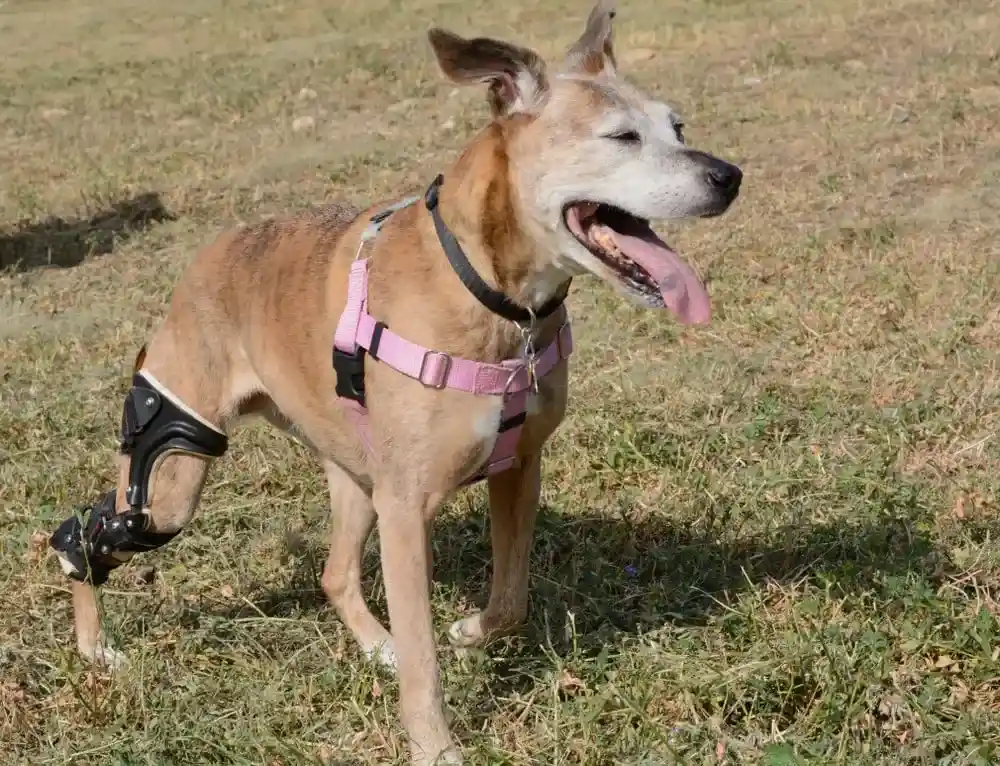PET HEALTH
A cruciate ligament injury in dogs occurs when the ligament in their knee joint tears or weakens, and can lead to pain and instability. These injuries can be a common cause of hind limb lameness, especially in active dogs. Just like athletes are prone to anterior cruciate ligament (ACL) injuries, dogs often face cruciate ligament tears.1
Below, we'll dive into the specifics of cruciate ligament injuries. Understanding the symptoms to watch out for, treatment options, and potential surgery costs can help you be prepared to get your dog the care they need as soon as possible.
When In Doubt, Get Your Dog Checked Out
What Are Cruciate Ligaments?
Cruciate ligaments are bands of tissue in a dog’s knee (or stifle joint) that help stabilize the knee and support movement. There are two of these ligaments: the cranial cruciate ligament (CCL) and the caudal cruciate ligament (CaCL).1
The CCL and CaCL ligaments allow the knee to function like a hinge while preventing a side-to-side motion and keeping the thigh bone (femur) and shin bone (tibia) aligned.1
The two ligaments cross over each other in the stifle joint to keep the femur and tibia bones stacked correctly. They’re called cruciate ligaments because they “cross over” each other in the knee joint, resembling a cross shape.1
What Causes Cruciate Ligament Injuries in Dogs?
Cruciate ligament ruptures in dogs can either be chronic or acute, both of which can lead to pain and lameness.1
Chronic injuries, also known as cruciate ligament disease, often result from degeneration due to repeated stress or arthritis. The ligaments gradually wear down from repeated twisting or stretching, which can lead to slow-onset lameness. In many cases, a vet can detect early signs of a chronic cruciate ligament injury before you notice any symptoms.1
Acute injuries happen when a dog suddenly overloads the joint, often during a quick change in direction while running or playing. Similar to an athlete tearing their ACL, this type of injury is immediate, and the dog will usually yelp, collapse, or limp after it happens.1
Cruciate Ligament Injury Risk Factors
Some dogs are more at risk for a cruciate ligament tear than others. Recognizing the following risk factors can help ensure your dog gets the help they need if they show signs of a torn cruciate ligament.2
- Overweight dogs: Carrying extra weight can put more pressure on the knee joints and can increase the chance of a cruciate ligament injury.
- Large-breed dogs: Dogs like golden retrievers, Labradors, Rottweilers, Newfoundlands, and German shepherds can be more prone to cruciate ligament injuries because of their larger size.
- Older dogs: As dogs age, their ligaments naturally weaken. This can make older dogs more susceptible to injuries, including cruciate ligament ruptures.
- Dogs with previous injuries: If your dog has already injured one cruciate ligament, they can be more likely to injure the other one. Shifting weight onto the uninjured leg can strain the joint and increase the risk of a second injury.
Cruciate Ligament Symptoms in Dogs
Cruciate ligament injuries, whether affecting the cranial (CCL) or caudal (CaCL) ligament, can cause a range of symptoms that may affect your dog’s ability to move and exercise comfortably. Some common signs of a cruciate ligament tear in dogs can include:1,2
- Limping or lameness
- Stiffness or swelling around the knee joint
- Difficulty rising, jumping, walking, or running
- Reluctance to exercise or play
- An awkward sitting position
- Decreased range of motion
- Muscle atrophy in the affected leg
- Crying out in pain when the joint is moved
- Favoring one leg over another
By catching these symptoms earlier on, your dog may be able to avoid cruciate injuries that can worsen over time and lead to conditions like osteoarthritis (OA).3
How To Diagnose a Cruciate Ligament Injury in Dogs
To diagnose a cruciate ligament tear, your veterinarian will usually start with a physical examination. This includes reviewing your dog’s medical history, testing for potential lameness, and performing a “drawer sign” test — where the vet gently moves your dog’s tibia. If it slides forward like a drawer, that could be a clear indication of a cruciate ligament tear.1,2,3
Your vet might also want to perform some X-rays to assess ligament damage and look for signs of arthritis or other joint issues. In some cases, vets might use other imaging tools, like MRI or CT scans, to get a clearer picture of the injury.1,2
In addition to these tests, your vet might place your dog under sedation and move the knee joint around.1 They may also perform a palpation test — a test where the vet uses their hands to feel around the affected area — to check for pain, stiffness, or swelling in your dog’s joint.4
Cruciate Ligament Dog Treatment Options
Many dogs with cruciate ligament injuries may need surgery. In smaller breeds (dogs under 33 pounds) or in cases where the ligament is only partially torn, your vet may call for rest, pain medication, and therapy to manage their condition. However, if the knee doesn’t heal properly, surgery may still be necessary to stabilize the knee joint.1
There are several surgical techniques used to repair cruciate ligaments. All involve removing damaged cartilage or ligament fragments and stabilizing the knee to prevent excessive movement between the femur and tibia.1
ECLS surgery
Extracapsular lateral suture (ECLS) surgery is one of the oldest methods for stabilizing a torn ligament. It involves placing suture material to act as an artificial ligament. The surgeon drills holes into the femur and tibia bones and loops the suture through, which helps hold the bones in place.3
This procedure is most effective for smaller to mid-sized dogs and costs between $750 and $2,000, on average.5
TightRope® procedure
The TightRope® procedure is similar to ECLS surgery but provides a stronger anchor by drilling channels through both bones, which creates a sturdier support for the suture.2,3 This method is also used primarily in smaller and mid-sized dogs, with costs ranging from about $1,000 – $2,000.5
TPLO surgery
Tibial plateau leveling osteotomy (TPLO) surgery repositions the knee joint rather than just stabilizing it. It’s often recommended for larger dogs because of the added weight they place on their knees.1,2,3
In TPLO surgery, a section of the tibia is rotated to change the angle between the tibia and femur. Metal plates and screws are used to secure the bones and help prevent future instability. This surgery can cost between $2,000 and $6,000.5
TTA surgery
Tibial tuberosity advancement (TTA) surgery is another option for large dog breeds. Similar to a TPLO surgery, it recreates the knee joint and restores proper function to your dog’s knee.1,3
For a TTA surgery, the veterinary surgeon cuts the tibia and inserts an orthopedic spacer to correct the knee’s alignment. A bone plate is then attached to hold the bone in place.2,4 This surgery generally costs between $3,000 and $6,000.5
What Does Dog CCL Surgery Recovery Look Like?
Helping your dog recover after cruciate ligament surgery takes some patience, but it’s key to their full recovery. While your vet may provide specific instructions, some of the key components of your dog’s post-operative care may include:1,2
- Medication: Give your dog their prescribed pain and anti-inflammatory medications to keep them comfortable after surgery.
- Limited activity and rest: Keep your dog’s activity levels low for the first 6 – 8 weeks. This means no running or jumping, and potentially crate rest to limit movement.
- Gradual reintroduction to movement: After about 3 months, your dog may start resuming their normal activities. Begin with short, controlled leash walks and slowly increase their activity levels.
- Physical therapy: Consider physical therapy exercises to rebuild your dog’s strength and improve flexibility in the knee joint.
- Maintaining a healthy weight: Keeping your dog at a healthy body weight during recovery can reduce pressure on their healing knee.
- Monitoring your dog’s progress: Attend any follow-up appointments to ensure your dog is healing properly. Also, watch out for signs of discomfort or unusual movement.
How To Cover the Cost of CCL Surgery for Dogs
Cranial cruciate ligament dog injuries can lead to costly vet bills. Surgery alone can range from $750 – $6,000, not including follow-up appointments, therapy, or pain medications.5 However, dog insurance may help you cover these expenses and can potentially reduce this financial burden.
For example, a mixed-breed dog from Alabama tore her cruciate ligament and needed surgery. The procedure cost about $5,000, and MetLife Pet Insurance covered about 90% of the vet bill.6 With the right coverage, your pup could benefit from protection like this.
Protect Your Dog From Costly Cruciate Ligament Injuries With Pet Insurance
Cruciate ligament injuries can be expensive, but the right pet insurance can help pet owners manage the costs, including surgery, medications, and follow-up care. By planning well-in -advance and getting coverage, you can be better prepared to manage the costs associated with this common dog injury.
Protect your dog by starting with a free quote today.
Dr. Hunter Finn has been paid by MetLife to discuss the importance of choosing pet insurance. He is an integrative veterinary expert first, and social media star second. America’s favorite veterinarian owns Pet Method in McKinney, Texas, where he cares for pets while prioritizing their emotional well-being. When he’s not at his clinic, he’s starring in viral videos on TikTok (2 million followers) and Instagram (500K followers) — where he’s been known to snuggle puppies and conquer the latest dance trends.



